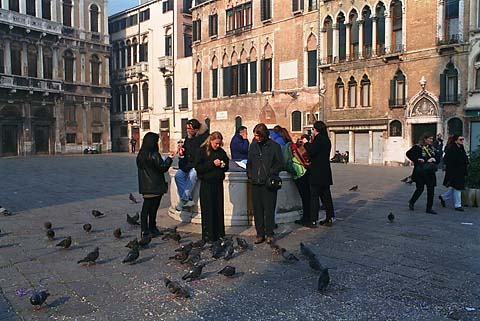  A Venetian square surrounded by four-story buildings
The book is generally known to planners but is only slowly beginning to influence actual planning and development. I anticipate that this trend will continue. Anyone interested in planning issues should read this book. The following patterns were very important in my thinking: Community of 7000 (Pattern 12), proposes neighborhoods with between 5,000 and 10,000 residents. I have adopted as a design target 12,000. Each neighborhood separates into two parts along the central boulevard, and the areas on either side of the boulevard can be treated as separate neighborhoods with populations of about 6,000. Four-Story Limit (Pattern 21) states: "In any urban area, no matter how dense, keep the majority of the buildings four stories high or less. It is possible that certain buildings should exceed this limit, but they should never be buildings for human habitation." It would be considerably simpler to design a carfree city in the absence of this limitation, but I believe that this pattern is so important that I have adopted it in the reference design for carfree cities. In practice, many wonderful urban areas have buildings as high as six stories, but my experience is that areas with buildings taller than that are almost never agreeable places to live. Work Community (Pattern 41), holds that a variety of uses should be included in every neighborhood. Jane Jacobs was probably the first to make this argument, in The Death and Life of Great American Cities. It runs counter to a long-held belief first expounded in 1898 by Ebenezer Howard, originator of the Garden City concept which formed the basis for Le Corbusier's scheme of high-rise buildings in park-like settings. Mixed uses lead to interesting, vibrant, and healthy neighborhoods.
Accessible Green (Pattern 60), cites research showing that people regularly use green space only if it is within a three-minute walk. I think that this can be stretched to five minutes if the walk is pleasant, safe, and unimpeded by cars. |
Return Home
About the book: Carfree Cities
E-mail
carfree.com
Copyright ©1996-2002 J.Crawford